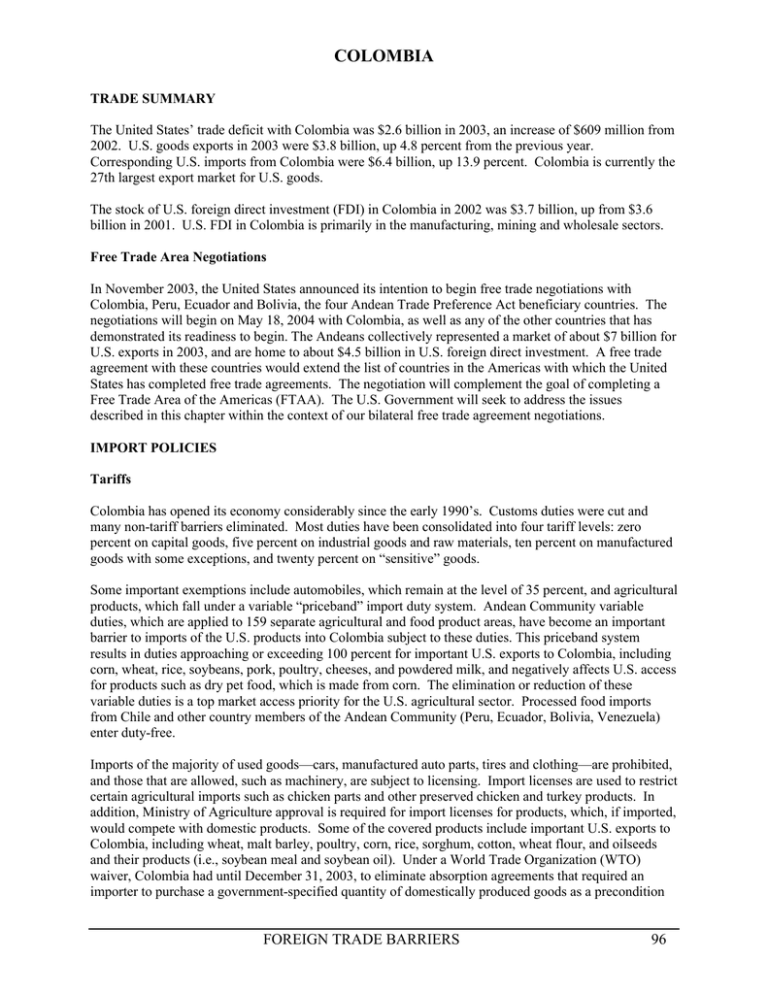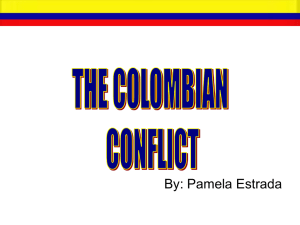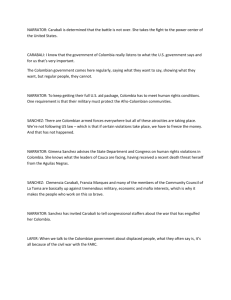COLOMBIA
advertisement

COLOMBIA TRADE SUMMARY The United States’ trade deficit with Colombia was $2.6 billion in 2003, an increase of $609 million from 2002. U.S. goods exports in 2003 were $3.8 billion, up 4.8 percent from the previous year. Corresponding U.S. imports from Colombia were $6.4 billion, up 13.9 percent. Colombia is currently the 27th largest export market for U.S. goods. The stock of U.S. foreign direct investment (FDI) in Colombia in 2002 was $3.7 billion, up from $3.6 billion in 2001. U.S. FDI in Colombia is primarily in the manufacturing, mining and wholesale sectors. Free Trade Area Negotiations In November 2003, the United States announced its intention to begin free trade negotiations with Colombia, Peru, Ecuador and Bolivia, the four Andean Trade Preference Act beneficiary countries. The negotiations will begin on May 18, 2004 with Colombia, as well as any of the other countries that has demonstrated its readiness to begin. The Andeans collectively represented a market of about $7 billion for U.S. exports in 2003, and are home to about $4.5 billion in U.S. foreign direct investment. A free trade agreement with these countries would extend the list of countries in the Americas with which the United States has completed free trade agreements. The negotiation will complement the goal of completing a Free Trade Area of the Americas (FTAA). The U.S. Government will seek to address the issues described in this chapter within the context of our bilateral free trade agreement negotiations. IMPORT POLICIES Tariffs Colombia has opened its economy considerably since the early 1990’s. Customs duties were cut and many non-tariff barriers eliminated. Most duties have been consolidated into four tariff levels: zero percent on capital goods, five percent on industrial goods and raw materials, ten percent on manufactured goods with some exceptions, and twenty percent on “sensitive” goods. Some important exemptions include automobiles, which remain at the level of 35 percent, and agricultural products, which fall under a variable “priceband” import duty system. Andean Community variable duties, which are applied to 159 separate agricultural and food product areas, have become an important barrier to imports of the U.S. products into Colombia subject to these duties. This priceband system results in duties approaching or exceeding 100 percent for important U.S. exports to Colombia, including corn, wheat, rice, soybeans, pork, poultry, cheeses, and powdered milk, and negatively affects U.S. access for products such as dry pet food, which is made from corn. The elimination or reduction of these variable duties is a top market access priority for the U.S. agricultural sector. Processed food imports from Chile and other country members of the Andean Community (Peru, Ecuador, Bolivia, Venezuela) enter duty-free. Imports of the majority of used goods—cars, manufactured auto parts, tires and clothing—are prohibited, and those that are allowed, such as machinery, are subject to licensing. Import licenses are used to restrict certain agricultural imports such as chicken parts and other preserved chicken and turkey products. In addition, Ministry of Agriculture approval is required for import licenses for products, which, if imported, would compete with domestic products. Some of the covered products include important U.S. exports to Colombia, including wheat, malt barley, poultry, corn, rice, sorghum, cotton, wheat flour, and oilseeds and their products (i.e., soybean meal and soybean oil). Under a World Trade Organization (WTO) waiver, Colombia had until December 31, 2003, to eliminate absorption agreements that required an importer to purchase a government-specified quantity of domestically produced goods as a precondition FOREIGN TRADE BARRIERS 96 COLOMBIA for the granting of import licenses. In February 2004, the government of Colombia enacted measures to replace this regime, and we are reviewing them for their WTO consistency. Wheat was excluded from this new mechanism and continues to pay the duty calculated under the Andean price band system. Colombia also assesses a discriminatory value-added (VAT) of 35 percent on whiskey aged for less than 12 years, which is more characteristic of U.S. whiskey, compared to a rate of 20 percent for whiskey aged for 12 or more years, most of which comes from Europe. STANDARDS, TESTING, LABELING AND CERTIFICATION The Colombian Ministry of Foreign Trade requires specific technical standards for a variety of products. The specifications are established by the Colombian Institute of Technical Standards (ICONTEC), a private non-profit organization, which provides quality certification and technical support services and serves as an Underwriters’ Laboratories (UL) inspection center. ICONTEC is a member of the International Standards Organization (ISO) and the International Electrotechnical Commission (IEC). In December 2001, the Ministry of Economic Development issued Resolutions 1190 through 1194, which eliminated mandatory compliance to technical standards on approximately 90 percent of the products previously subject to such requirements. Certificates of conformity are no longer a prerequisite for importing most products that are subject to technical standards. According to U.S. industry, Colombian requirements for phytosanitary registrations to bring new products into the market are excessive and often take as long as six to eight months to fulfill. Colombia maintains trade-restricting requirements for listing of ingredients by percentage on pet food. GOVERNMENT PROCUREMENT In July 2003, the Colombian government promulgated Law 816 to protect national industries in government procurement. Law 816 mandates that all public entities adopt criteria that support national industries and accords preferential treatment to bids that incorporate Colombian goods or services. Under Law 816, national companies are given a 10 percent to 20 percent “bonus” in their evaluation score, and companies using Colombian goods or services are given a 5 percent to 15 percent bonus. Bids without any Colombian component are scored between 5 percent and 20 percent lower than national ones. Additionally, Law 816 requires foreign suppliers without local headquarters in Colombia to obtain certification from a Colombian mission overseas that government procurement laws in the home country meet reciprocity requirements. To date, this new system, and specifically the lack of an established certification process, has proven to be a barrier against the participation of U.S. suppliers in government procurement contracts. There have been complaints of non-transparency in the awarding of major government contracts. However, the Colombian government has taken positive steps to fight corruption, such as working with non-governmental organizations to launch probity programs aimed at promoting entrepreneurial and public ethics. Colombia is still not a signatory of the WTO Agreement on Government Procurement. EXPORT SUBSIDIES Colombia has been working to eliminate export subsidies since its GATT accession. This process has continued under the WTO Agreement on Subsidies and Countervailing Measures. In June 2003, the Colombian Government announced that it would eliminate the tax benefits linked to exports and will replace them with other incentives for employment generation and investment in new technologies. Colombia agreed to phase out all export subsidies in free trade zones by December 31, 2006. Free trade zones and special import-export zones will maintain their special customs and foreign exchange regimes. FOREIGN TRADE BARRIERS 97 COLOMBIA Colombia’s tax rebate certificate program (CERT) contains a subsidy component, which the Government of Colombia has stated it will replace with an equitable drawback system, although it has not yet done so. In late August 2002, the Colombian government effectively eliminated the CERT, reducing it to zero percent. Although this means that the subsidy component has disappeared, the CERT has not been eliminated, and it could be increased in the future when Colombia’s budgetary conditions improve. For example, in July 2003 the Colombian government approved approximately $7 million for CERT payments to banana exporters. The other export subsidy, known as the “Plan Vallejo,” allows for duty exemptions on the import of capital goods and raw materials used to manufacture goods that are subsequently exported. INTELLECTUAL PROPERTY RIGHTS (IPR) PROTECTION Colombia has been on the Special 301 “Watch List” or “Priority Watch List” every year since 1991. In 2003, the International Intellectual Property Alliance (IIPA) recommended that Colombia remain on the Special 301 Watch List because of its continued difficulties in copyright enforcement. Colombia, which is a WTO member, has ratified its legislation to implement its obligations under the Uruguay Round Agreement on Trade-Related Aspects of Intellectual Property Rights. Colombia is a member of the World Intellectual Property Organization (WIPO), the Paris Convention for the Protection of Industrial Property, and the 1978 Union for the Protection of New Plant Varieties, and a signatory to the Patent Cooperation Treaty. Patents and Trademarks The patent regime in Colombia currently provides for 20-year protection for patents and reverses the burden of proof in cases of alleged process patent infringement. Provisions covering protection of trade secrets and new plant varieties have improved Colombia’s compliance with its TRIPS obligations. In 2002, the Colombian government issued Decree 2085, which improved the protection of confidential data. Until 2002, Government of Colombia health authorities approved the commercialization of new drugs that were the bioequivalents of already-approved drugs, thereby denying the originator companies the exclusive use of their data. However, Decree 2085 prohibited this practice, thus providing improved protection for industrial information. Under the decree, data presented for health certification of pharmaceuticals is protected for a period of three years for registrations issued in 2002, four years in 2003, and five years in 2004 and beyond. In May 2003, the Agricultural Ministry promulgated Decree 505 that provides similar protection for agricultural chemicals. Colombia is a member of the Inter-American Convention for Trademark and Commercial Protection. Enforcement of trademark legislation in Colombia is showing some progress, but contraband and counterfeiting are widespread. The Superintendence of Industry and Commerce acts as the local patent and trademark office in Colombia. This agency was given the control of the government’s IPR policy, effective January 2000. However, the agency suffers from inadequate financing and a large backlog of trademark and patent applications. Copyrights Andean Community Decision 351 on the protection of copyrights has been in effect in Colombia since January 1, 1994. Colombia also has a modern copyright law: Law 44 of 1993. The law extends protection for computer software to 50 years but does not classify it as a literary work. Law 44 and Colombia’s civil code include some provisions for IPR enforcement and have been used to combat infringement and protect rights. Colombia is a member of the Berne and Universal Copyright Conventions, the Buenos Aires and Washington Conventions, the Rome Convention for the Protection of FOREIGN TRADE BARRIERS 98 COLOMBIA Performers, Producers of Phonograms and Broadcasting Organizations, the Geneva Convention for Phonograms, the WIPO Copyright Treaty, and the WIPO Performances and Phonograms Treaty. It is not a member of the Brussels Convention relating to the Distribution of Programme-Carrying Signals Transmitted by Satellite. Colombia’s Criminal Code of 2001 includes copyright infringement as a crime, and significantly increased jail terms from three to five years. The code also contains provisions regarding the violation of technological protection measures and rights management information, both key obligations of the WIPO treaty. Colombia has also created a Special Investigative Unit within the Prosecutor General’s Office dedicated to intellectual property rights issues. This unit began functioning in November 1999 and is currently working on a number of cases against pirate television programming broadcasters. Piracy levels in Colombia exceed half the legitimate market in almost all the copyright sectors. The International Intellectual Property Alliance estimates that in 2003 piracy levels in Colombia for recorded music reached 70 percent with damage to U.S. industry estimated at about $50 million, while motion picture piracy represented 75 percent of the market, valued at a loss of an estimated $40 million. A major intellectual property rights issue has been the need for the Colombian government to license legitimate pay television operators and to pursue pirate operators. The Motion Picture Association of America (MPAA), in conjunction with local attorneys, took 17 criminal actions against alleged television pirates in 2000, 16 such cases in 2001, and eight in 2002. However, MPAA’s anti-piracy strategy relied on enforcement by the Colombian National Television Commission (CNTV), which largely failed in its efforts. Given the CNTV’s poor results in suppressing piracy, MPAA has ceased initiating action against television broadcast or home video piracy. Colombia’s Television Broadcast Law increased legal protection for all copyrighted programming by regulating satellite dishes, and enforcement has begun through a licensing process. However, the MPAA claims that despite several years of promising administrative action to enforce copyright, CNTV has been completely ineffective in addressing the problem of piracy in television. An MPAA estimate suggests that 90 percent of the motion picture market in Colombia is pirated, while annual losses due to audiovisual piracy remained at $40 million in 2002. SERVICES BARRIERS Liberalization has progressed furthest in financial services, telecommunications, accounting/auditing, energy, and tourism. It has occurred to a lesser extent in legal services, insurance, distribution services, advertising, and data processing. The provision of legal services is limited to law firms licensed under Colombian law. Foreign law firms can operate in Colombia only by forming a joint venture with a Colombian law firm and operating under the licenses of the Colombian lawyers in the firm. Colombia permits 100 percent foreign ownership of insurance firm subsidiaries. It does not, however, allow foreign insurance companies to establish local branch offices. Insurance companies must maintain a commercial presence in order to sell policies other than those for international travel or reinsurance. Colombia denies market access to foreign maritime insurers. A commercial presence is required to provide information processing services. Foreign educational institutions must have resident status in Colombia in order to receive operational authority from the Ministry of Education. Cargo reserve requirements in transport have been eliminated. However, the Ministry of Foreign Trade reserves the right to impose restrictions on foreign vessels of nations which impose reserve requirements on Colombian vessels. Colombia also restricts the movement of personnel in several professional areas, FOREIGN TRADE BARRIERS 99 COLOMBIA such as architecture, engineering, law, and construction. For firms with more than ten employees, no more than ten percent of the general workforce and 20 percent of specialists may be foreign nationals. Financial Services Colombian legislation permits 100 percent foreign ownership in financial services, although the use of foreign personnel in the financial services sector remains limited to administrators, legal representatives, and technicians. In April 2000, the Central Bank completely removed previous reserve requirements on foreign borrowing operations. Such reserve requirements on foreign loans were designed to reduce the amount of import-related debt. Basic Telecommunications Services In the WTO negotiations on basic telecommunications services, Colombia made fairly liberal commitments on most basic telecommunications services and adopted the WTO reference paper. However, Colombia specifically prohibited “callback” services and excluded fixed and mobile satellite systems. The license or concession for the supply of telecommunications services is only granted to enterprises legally established in Colombia. Currently, foreign investment is allowed in telecommunications firms, but under its WTO commitments, Colombia reserves the right to limit foreign investment in these firms based on an economic needs test. In general, for certain key services such as carrier, national, and international long-distance, and cellular mobile telephony, foreign investment is permitted up to a maximum of 70 percent of the capital of the enterprise licensed to operate. While Colombia has allowed new competitors into long distance and international services, high license fees are a significant barrier. For cellular mobile telephone service, the country was divided into three regions; in each one the service was supplied by two exclusive operators until September 1999. Thereafter, a few additional operators entered the market. Private licensed companies must be established as “open” corporations in which no single person or group can hold more than 30 percent of the company and the shares must be listed in Colombia’s stock exchange. In 2003, Colombia opened the telecommunications market to Personal Communications Services (PCS) competition. The government issued a PCS license to new competitor Colombia Movil, effectively ending Colombia’s mobile telecommunications duopoly (Bellsouth and Comcel share approximately 80 percent of the cellular market) and opening the door for competition. The bidding winner, Colombia Movil, received a 10-year concession to develop the market and compete against the current cellular providers. Audiovisual and Communication Services As part of the de-monopolization of Colombia’s government-owned television network, Colombia passed the Television Broadcast Law, Law 182/95, effective January 1995, which increased protection for all copyrighted programming by regulating satellite dishes and permitting private television broadcasters to compete with the government-owned broadcaster. The law increased restrictions on foreign content in broadcasting and imposed a burdensome system of sub-quotas for different hours of the day. The law requires broadcasters to transmit 70 percent locally-produced programming during prime time and a range of zero to 40 percent during other times on national television and 50 percent locally produced programming on regional channels and local stations. Retransmissions of local productions are considered to fulfill only part of the national content requirement. Foreign talent may be used in locally produced programming, but the quasi-independent National Television Commission (CNTV) sets limits. FOREIGN TRADE BARRIERS 100 COLOMBIA INVESTMENT BARRIERS Colombian law provides for national treatment for foreign investment. One hundred percent foreign ownership is permitted in most sectors of the Colombian economy. Exceptions include activities related to national security and the disposal of hazardous waste. Investment screening has been largely eliminated, and the mechanisms that still exist are generally routine and non-discriminatory. All foreign investment must be registered with the Central Bank’s foreign exchange office within three months in order to ensure the right to repatriate profits and remittances. All foreign investors, like domestic investors, must obtain a license from the Superintendent of Companies and register with the local chamber of commerce. All foreign investment in petroleum exploration and development in Colombia must be carried out under an association contract between the foreign investor and Ecopetrol, the state oil company. In view of Colombia’s need for new oil discoveries, the government implemented a new hydrocarbon policy designed to attract foreign oil companies to Colombia which reduced Ecopetrol's mandatory share in joint ventures from 50 percent to 30 percent and changed royalties from a flat 20 percent to a sliding scale from 8 percent to 25 percent, depending on the size of the field. The Colombian government also restructured Ecopetrol and created the National Hydrocarbon Agency (ANH) in mid-2003. Ecopetrol will be an operating company while the ANH will regulate the sector. The government has announced its intention to extend existing contracts. After 2004, association contracts may be replaced by concession agreements between newly created AHN and multinational companies. Colombian television broadcast laws (Law 182/95 and Law 375/96) impose several restrictions on foreign investment. For example, foreign investors must be actively engaged in television operations in their home country and their investments must involve an implicit transfer of technology. The National Planning Department issued a new Foreign Investment Regime -- Decree 2080 of October 18, 2000 -- that unified foreign investment regulations, revoking all the rules on the subject previously dispersed into various decrees. Decree 2080 eliminated percentage limits previously placed on foreign equity participation as well as limits on foreign participation in audiovisual and radio services. ELECTRONIC COMMERCE Colombia’s electronic commerce Law 527 of August 1999 provides electronic documents and signatures the same legal recognition as paper documents and provides a framework for their use. Law 527 allows for, and regulates, the issuance of digital certificates and grants enforcement and oversight responsibilities to the Superintendent of Industry and Commerce. Decree 1747 of September 11, 2000, regulates Law 527 with regard to certificates and digital signatures, and establishes minimum capital and other requirements for certifying agencies to be approved by the Superintendent of Industry and Commerce. In May 2000, the Colombian and U.S. Governments signed a joint declaration on Electronic Commerce to increase transparency in the sector. According to the Bogota Chamber of Commerce, the Colombian electronic commerce market was estimated at $370 million in 2003. Electronic commerce in Colombia has grown at an annual rate of approximately five percent since 1997. Electronic commerce providers have contended with a weak level of computer penetration, lack of Internet accessibility (only 2.5 percent of the population or approximately 1.1 million people,) and per-minute phone charges for Internet usage that discourage browsing and web surfing. The development of Colombia’s electronic commerce market will also be contingent upon improvements in telecommunications, the postal service, and credit card usage. FOREIGN TRADE BARRIERS 101





